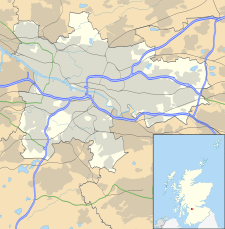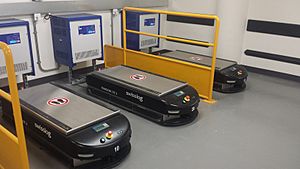Queen Elizabeth University Hospital facts for kids
Quick facts for kids Queen Elizabeth University Hospital |
|
|---|---|
| NHS Greater Glasgow and Clyde | |
 |
|
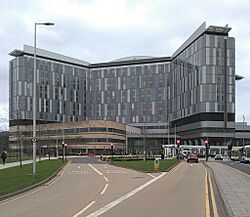
The QEUH building as viewed in March 2021
|
|
| Geography | |
| Location | 1345 Govan Road, Govan, Glasgow, Scotland |
| Coordinates | 55°51′44″N 04°20′28″W / 55.86222°N 4.34111°W |
| Organisation | |
| Care system | NHS Scotland |
| Hospital type | Teaching |
| Affiliated university | University of Glasgow Glasgow Caledonian University University of the West of Scotland |
| Services | |
| Emergency department | Yes (and Major Trauma) |
| Beds | 1,677 256 Children |
| Speciality | General |
| History | |
| Founded | April 2015 |
The Queen Elizabeth University Hospital (often called QEUH) is a very large hospital in Govan, Glasgow, Scotland. It has 1,677 beds for patients. This hospital was built where the old Southern General Hospital used to be. It opened its doors in April 2015.
The QEUH is actually made up of several parts. It has a big hospital for adults with 1,109 beds. There's also a special hospital for children with 256 beds. Both hospitals have their own emergency rooms. There's also a special unit for patients sent directly by their local doctors. Some older buildings from the Southern General Hospital are still used. These include the Maternity Unit, the Institute of Neurological Sciences, the Langlands Unit for older patients, and the laboratory.
Even though some parts, like the Royal Hospital for Children, feel like separate places, they are all connected. Patients can be easily moved between them. They share services like tests and emergency care. There's even a fast lift from the helicopter pad on the roof of the adult hospital. The new children's hospital is linked to the adult hospital. Both are also connected to the maternity building and the Neurosciences Institute.
This huge hospital campus is run by NHS Greater Glasgow and Clyde. It is one of the biggest hospital sites in Europe.
Contents
Building the Hospital
In 2008, the health board for Glasgow, NHS Greater Glasgow and Clyde, asked the Scottish Government for a new hospital. They wanted to replace older hospitals like the Western Infirmary and Victoria Infirmary. They also planned to move the Royal Hospital for Sick Children, Glasgow into a new building next to the adult hospital.
The plans for the hospital were shown in November 2009. The government agreed to pay for it. The adult hospital, children's hospital, and laboratory buildings were designed by Nightingale Associates. The company Multiplex built them. This company also built Wembley Stadium.
Cost and Name
This hospital was Scotland's biggest ever NHS building project paid for by the public. It cost £842 million to build. Construction started in early 2011 on the site of the old Southern General Hospital.
It was first going to be called South Glasgow University Hospital. But Queen Elizabeth II gave permission for it to be named the "Queen Elizabeth University Hospital." The hospital was hoped to be ready by 2014. However, patients and services started moving in April 2015. It was fully open by summer 2016.
Connecting the Buildings
A special walkway was built above ground. It connects the main hospital building to the Maternity and Neurosciences Institute buildings. This means most of the campus can be walked through without going outside. The main hospital is also linked to the laboratory buildings by a tunnel and a system that sends things through tubes using air pressure.
The older buildings, like the Institute of Neurological Sciences, also got a makeover. New panels were added to the outside to make them look like the new hospital buildings. This cost about £40 million.
When the hospital first opened, some local people started calling it the "Death Star". This was because of its star-shaped design, huge size, and the helicopter landing pad on the roof.
Hospital Services
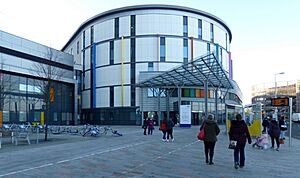
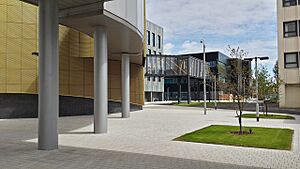
Adults' Hospital Facilities
The adult hospital building is 60 meters (about 197 feet) tall. It has 14 floors and four "wings." There are 1,109 patient rooms. Each room in the general wards has a window view. They also have their own shower and toilet. Patients can enjoy TV and radio in their rooms.
On the first floor, there is a large restaurant with 500 seats and a separate cafe. The main entrance area, called the atrium, has shops and cash machines. There's also a smart lift system that helps people find the quickest lift to their destination. Besides the restaurant and coffee shop, the atrium has shops like Marks & Spencer and WHSmith. It is thought that this hospital serves about 41% of Scotland's population.
Children's Hospital Facilities
The Royal Hospital for Children is connected to the adult hospital. It has 256 beds and five floors. This new hospital replaced the old Royal Hospital for Sick Children, Glasgow that was in Yorkhill.
Maternity Unit Services
The maternity unit was built in 1970. It was part of the old Southern General Hospital and is still used today. It is located right across from the children's hospital.
Institute of Neurological Sciences
The Institute of Neurological Sciences (INS) was built in 1972. It was also part of the old Southern General Hospital. This institute helps people with brain and nerve problems. It offers services like brain surgery, nerve studies, and special X-rays. It has two buildings connected by a bridge.
The main INS building has critical care, 6 operating rooms, and 4 patient wards. The second building, the Neurology Block, has outpatient clinics and two patient wards. The Physically Disabled Rehabilitation Unit (PDRU) helps patients with nerve injuries get better. The Queen Elizabeth National Spinal Unit for Scotland is also here. It helps people from all over Scotland with spinal injuries. About 60% of the work at INS is for emergency cases.
Langlands Building Services
The Langlands Building holds the unit for medicine for older people. It was built in 2001 and was also part of the Southern General Hospital. It is at the south end of the hospital campus. It is connected to the rest of the hospital through the Institute of Neurological Sciences.
Laboratory Services
The laboratory building was built in 2012. It was also part of the Southern General Hospital. This lab handles tests for all of Scotland. It has space for blood tests, genetics, and studying germs. It also houses the hospital's management offices and staff. The mortuary is in the basement. More than 800 people work in the laboratory, and they also do research.
Getting to the Hospital
The hospital has an "Arrival Square" at the front entrance of the adult hospital. This area is designed for all kinds of transport. There are places for patients to be dropped off. You can also catch buses that go all over the city. There's a walkway connecting the adult and children's hospitals and a taxi stand. About 90 buses an hour serve the hospital. There are also 500 bike racks for those who cycle.
The closest train station is Cardonald railway station. The nearest Glasgow subway station is Govan subway station.
Automated Vehicles
The adult, children's, and laboratory buildings use 26 special robots called automated guided vehicles (AGVs). These robots carry supplies around the hospital. They use their own lifts and a network of tunnels in the basement.
The robots have separate lifts for clean and dirty items. They travel in special corridors in the basement that are not used by the public.


